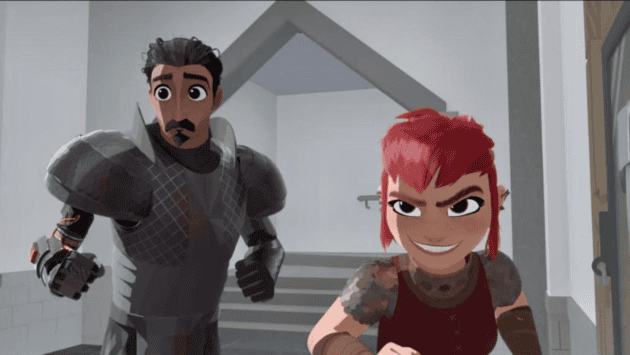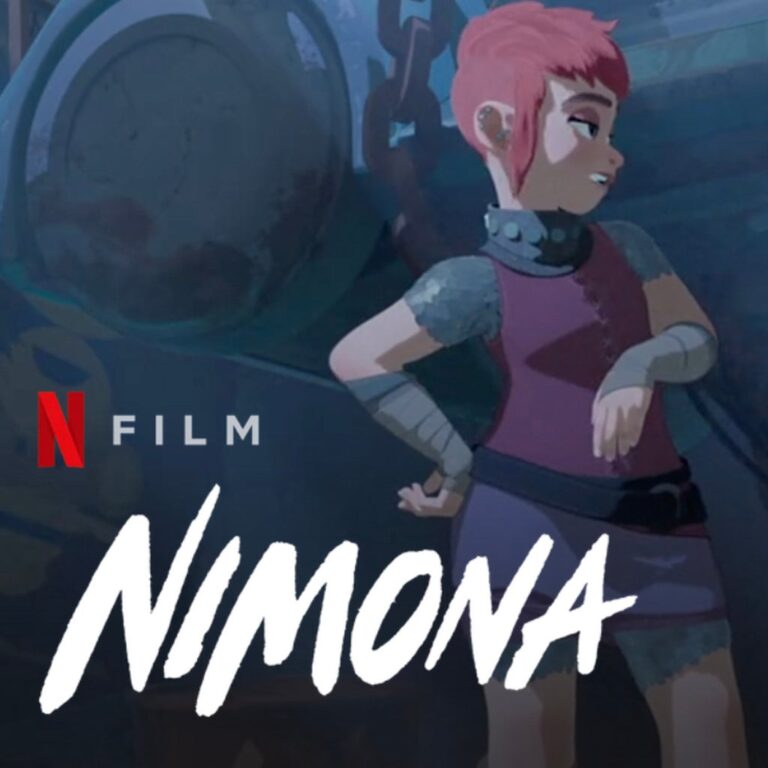Nimona – Snapshot
Nimona is an interesting exploration of non-binary gender identity in a science fiction/fantasy setting. It deserves an “A” for the strong social statement it makes, but is maybe a little weak as animation. (3.5*)
Where to Watch:
Stream: Netflix
Rent/Buy: (Nowhere)
Nimona – The Oscar Buzz
Oscar Nominations (1) / Oscar Wins (0) :
Animated Feature
Nimona was nominated only for Animated Feature and its production history suggests it was lucky to even make it to release. It was originally under Blue Sky Studios but was shut down by the pandemic and Disney in 2021. A year later, it was picked up by Annapurna and released through Netflix.
Although I’m sure a number of animation, sound, and visual effects people moved with the switchover, the core team members in film direction, story and screenplay, and overall art and production design seem to have been involved in the movie Spies in Disguise (19), which I have not seen. (The story and characters are largely from the web comic and graphic novel, Nimona, which I also have not seen or read. I write more about the creator, ND Stevenson in the Special Mention section below.). There are additional linkages to other films, listed in the next section.
Nimona – Related Movies
Spies in Disguise (Direction, Story/Screenplay, Production Design, Some Animation Team Members)
Nimona (Graphic Novel and Web Comic) (Story & Characters)
Big Hero 6 (Story/Screenplay, Production Design)
Ralph Breaks the Internet/ Moana/ Kuba and the Two Strings/Onward (Story/Screenplay)
Mary Poppins Returns (Production Design)
Sound of Metal (Ahmed – Ballister)
Joker (Conroy – The Director)
Nimona – What Others Think
Although the viewing audience is rather small, they are fairly enthusiastic about this movie, ranking it second of the five Animated Feature films, behind Spider-Man: Across the Spider-Verse. Nimona ranked thirteenth (in the top third!) of all 38 of this year’s films according to audience opinion. The people who saw this film generally liked it.
Critics were not extending as much love. They ranked it fourth among the animated feature films, but well ahead of Elemental. Among all 38 nominated films, it came in 24th, nearly into the bottom third. Simon Abrams (RogerEbert) really didn’t like the movie calling it “A sometimes cute but mostly hyper and overextended animated sci-fi fantasy” with “Bumper-sticker-ready slogans”. He characterized Nimona as “not a character: she’s whatever the scene needs her to be…a big mood board.” Amy Nicholson (New York Times) wasn’t much kinder calling it “A rush job with little resemblance to the much bleaker web comic.” She continued “Tone is uneasy teetering on anarchic, veering from giddily moronic one-liners to- more shockingly – a climax with deep empathy and visual awe.” At the end, though, she does call it “a big message film that wants audiences to reflect on social paranoia.”
Combining both audience and critical rankings, Nimona comes in 20th out of this year’s films and next to the last in animated features (ahead of Elemental!). That means it’s right about in the middle of this year’s movies – not exactly a dismissal, but not a sterling recommendation either.
Nimona – Special Mention
ND Stevenson and Transgenderism – ND Stevenson is the original creator of the character Nimona which appeared in a webcomic and graphic novel of the same name, long before this movie. Stevenson was born Noelle Diana Stevenson in 1991 into an evangelical family in Columbia, SC. Realizing he was transmasculine and nonbinary, he changed his name to Nate Diana Stevenson and later became known simply as ND. He has had what is called “top surgery” (which I understand is the removal of breast tissue) and in 2019 he married Molly Knox Ostertag, a female cartoonist. Clearly he is an active and full participant in the transgender world.
Stevenson created the Nimona character as a junior at Maryland Institute College of Art in 2012. He is currently continuing his work with Netflix on possible sequels to Nimona as well as the TV series, She-Ra and the Princesses of Power. Stevenson uses his art to further understanding of transgender and non-binary gender definitions.
Based on pictures of Stevenson, it seems impossible to not see that Nimona is a cartoon version of himself. And it seems pretty clear that the Nimona story is a projection of Stevenson’s own life into a comic book, fantasy world. The story deals with complex issues of people viewed as “monsters” and not welcome in the real world. The power structure in the movie is embedded in something called “The Institute” which is also the name of the college where he honed his artistic skills and, probably, refined his gender identity. He is quoted as saying “The world is so much bigger and weirder than we know – when you love someone for who they are, the understanding will follow.”
Transgenderism and non-binary genders are something that, admittedly, I accept, but do not understand. And I’m not sure I am the one to try and explain them here in this movie review. What research I did turns up that the issues surrounding gender identities other than standard male/female cisgenders are difficult to pin down because there simply aren’t standardized definitions – people sort of have their own definitions to suit their own needs. Stevenson, for example, calls himself “transmasculine” and while I have some idea that means someone born “female” but identifying also as a “male”, the word is not really defined anywhere I could find.
It also doesn’t help that people often confuse sexual identity with sexual orientation and it should be noted that they are very different. Sexual orientation has to do with whom one chooses as partners for sexual gratification while sexual identity has more to do with how one views the self, not others. So the whole thing becomes very hard to fully understand. I believe, though, that Nimona is one of Stevenson’s attempts to portray his own experiences in a way that helps shed at least some light on a difficult subject.
Nimona – Michael’s Moments
If you view Nimona through the lens of its creator’s gender identity, the movie takes on layers of meaning that might otherwise escape the viewer. Early in the movie, the two knights-in-training, Ambrosius and Ballister, hold hands and enjoy a quiet romantic evening. And later in the film, there is a full on kiss between them which, I believe, is the first time I’ve seen a male-male kiss in an animated film. So clearly the world we are presented has different and more accepting notions of sexual orientation than our own.
But the movie goes well beyond that. Nimona is voiced by Chloe Grace Moretz who is obviously female, but she is also known for playing roles that often explore darker and heavier angles, such as Wednesday in The Addams Family (19) movie, Mindy in Kick-Ass, or Carrie in Carrie. All of those roles involved more masculine characteristics of emotional reserve or downright aggression. So to see Nimona always wanting to “break stuff” isn’t surprising in this context and is portrayed well by Moretz. Aside from Moretz’s definitely-female voice, Nimona’s sexual identity is difficult to precisely define.
We learn early in the film that Nimona is a shape-shifter, capable of becoming any number of different animals, depending on the requirements of the situation. At one point, she even becomes a nefariously cute little boy. Clearly the shapeshifting is a reflection of Stevenson’s own ability to navigate between different gender roles.
But the shapeshifters are seen by the power structure of this made-up world as “monsters”. And that is precisely Stevenson’s perception of how transgender people are perceived in our world, which is the biggest statement that the movie tries to make. The film is a metaphor for how transgenders experience hostility in our own world and serves as distinct contrast to how much better, if still incomplete, our society has accepted alternate sexual orientations. So Nimona deserves great respect for the overall message it tries to communicate – it is as New York Times critic Amy Nicholson said, a “big message film” reflecting on “social paranoia”.
But although I enjoyed the hidden themes and social activism, I’m not sure the film is a great animated movie. The portrayal of a society with medieval social institutions while possessing super-modern technology was intriguing at points, but led to many inconsistencies. And there is some merit to the notion that the Nimona character ends up saving any scene simply because she can change shapes so quickly. But her relationship with Ballister is undeveloped and the love relationship between the two knights isn’t carried out very well (as pointed out in the movie “arm-chopping is not a love language”!). The animation itself seems choppy and the emotional expressions seemed weakly engaged.
In short, the film has an intriguing premise and deserves an “A” for a gutsy statement. And it has some terrific one-liners that will keep adults on their toes. But it isn’t going to please everyone and makes you wonder why they are already talking about sequels. (3.5*)


